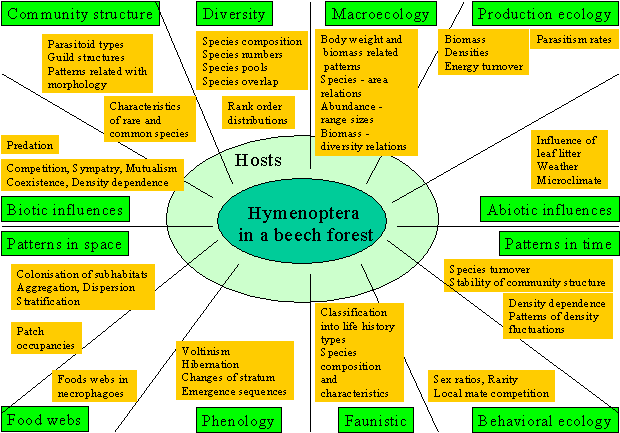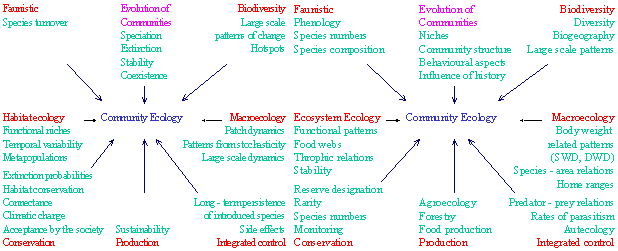Monografie
Hymenopteren in einem Kalkbuchenwald
Parasitic Hymenoptera are one of the most species-rich taxa of our temperate habitats. Mean annual species numbers of European forests range between 400 to 600 species. The total number of Hymenopteran species in Europe exceeds probably 20000 species. Unfortunately, any detailed study of communities of parasitic Hymenoptera is confronted with the enormous difficulties connected with the taxonomy of the group. Detailed ecological work that deals with the whole guild at ecosystem level is therefore largely missing. The parasitic Hymenoptera in a beech forest on limestone is an attempt to fill this gab in our knowledge. It contains the summary of a long-term study of the ecology of parasitic Hymenoptera in a German beech forest (the Göttingen forest).
The Figure below shows the width of the study program

The parasitic Hymenoptera in a beech forest on limestone is a monograph that first appeared in a printed version (Forschber. Zentr. Waldschadensf. Bd. 149, 2001: 1-249).
You can download the complete text as a pdf-file. The file has about 2.56 MB.
Die Hymenopteren einer Wiese auf Kalkgestein
This is the second monograph dealing with the community ecology of the Hymenoptera. This time the community of 475 mainly parasitic Hymenoptera of a meadow on a hill on chalk in Northern Germany is described. Major attention receive ecological patterns that depend on species body sizes. Metabolic theory, temporal and spatial species turnover, and abundance distributions are discussed in detail. The Hymenoptera of a meadow on limestone is an attempt to infer whether major recent ecological theories are applicable at the local scale. It is also a data source about the diversity of Hymemoptera in open temperate habitats.
Approaches to community ecology

The Hymenoptera of a meadow on limestone is a monograph that first appeared in a printed version (Forschber. Zentr. Waldschadensf. Bd. 195, 2005: 1-203).
You can download the complete text as a pdf-file. The file has about 2.56 MB.

 ul. Lwowska 1, 87-100 Toruń
ul. Lwowska 1, 87-100 Toruń![Katedra Ekologii i Biogeografii [fot. Katedra Ekologii i Biogeografii] Katedra Ekologii i Biogeografii [fot. Katedra Ekologii i Biogeografii]](http://www.umk.pl/wiadomosci/serwisy_wp/gallery/1503/medium/KEiB.jpg)